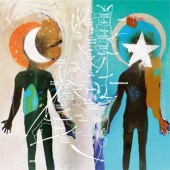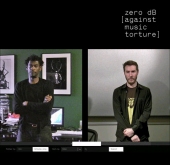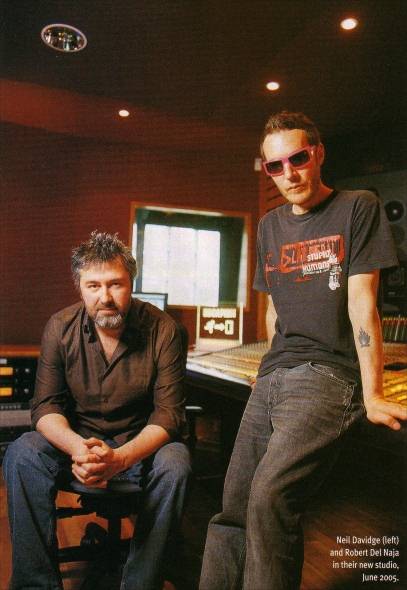
Massive Attack's New Studio
Robert Del Naja • Neil Davidge
Production pioneers Massive Attack are going through exciting times; they've built an awesome recording studio, they've moved into surround soundtrack work, and there's a new album on the way. We take a look around their new workspace.
With the proliferation of low-cost recording equipment on the market, it's not surprising so many artists have set up private project studios. Indeed, there's a long tradition of bands investing money in their own equipment, both to defray future recording costs and to provide a creative environment that they can use whenever they want.
However, there's a world of difference between a small project studio designed for writing and pre-production, and a full-blown 5.1-capable recording facility that can be used to record and mix an entire album or film music project. If you're going to put something like that together, you have to be pretty sure of your finances, and see the investment as a long-term career strategy that fits in with the way you want to record.
This perfectly describes what Bristol band Massive Attack have done. With four internationally successful studio albums to their credit — all of which have been hailed as groundbreaking in terms of creative content and technical aspirations — the band are undoubtedly financially secure enough to consider such a brave move. And they'd certainly outgrown their project studio — a couple of programming suites at Christchurch Studios, Bristol.
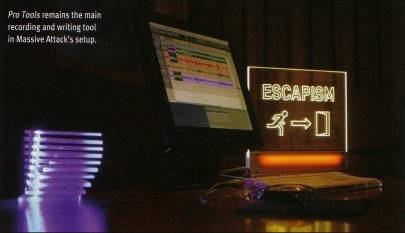
A Place Of Our Own
"I've been pushing the band to make a decision about having a proper studio for some time," says Neil Davidge, who co-wrote and co-produced the last two Massive Attack albums, Mezzanine and 100th Window. "If music is your career and what you put your life into, then there comes a point when you've got to put roots down and really make a commitment to the way you want to work. But even for Massive Attack, where it makes absolute economic and creative sense to have our own studio, it still took nearly six years to get from talking about it to building it."
The new facility Davidge refers to is bound to be called the Massive Attack studio, although it actually belongs personally to Davidge and Robert Del Naja, the creative force behind Massive Attack. Nevertheless, it's where most of the work will now be done on Massive's future projects, because Del Naja has chosen to make it his base. "This is something we've always wanted" he says.
" When the band was first formed, our two aims were to get our own studio and our own label, and in an idealistic way, become self-sufficient. The label idea went by the wayside, but my relationship with Neil has made the studio a reality, and I'm really excited by the creative possibilities it opens up for us.
"We wanted to get out of the cycle of hiring studios to make albums, and then promoting and touring them because there isn't much flexibility in that" continues Del Naja. "Creativity isn't something you can easily define because it comes and goes in a very random way. I've lost track of the number of times I've gone on writing weekends or holidays and done nothing, only to find myself facing a really busy time but unable to sleep because I've got so many ideas in my head. That's the perverse nature of creativity, but having our own studio gives us an outlet for it, because we can come in here and use it whenever we want.
"Massive Attack is very much a communal group and doesn't operate like a traditional band. We've always incorporated lots of different people, different ideas and different equipment. Now we have the scope to extend that philosophy — one day we could be working with a film director, the next a new drummer. It doesn't matter, as long as they bring something new to what we do. I've always worked best when I'm multitasking. My mind does wander from place to place, so it's good if there are lots of different things going on. This contrasts nicely to how Neil is, because he's much better at dedicating himself to something and immersing himself in it. The differences between us make for a great working relationship because he brings concentration to some of my wilder ideas."
"I had my own personal reasons for wanting to build a studio, but from the band's point of view it always made sense, because of the way in which they record," explains Neil Davidge. "With Massive Attack, it's not about sitting down with an acoustic guitar or piano, writing a song, going into a studio, recording it and then mixing it. That's just not how we work. What we tend to do is build the sound up in layers, which can be a much more convoluted process.
"We usually start with a few basic ideas — perhaps some rhythm patterns or a keyboard part or a bit of guitar — then we build on that melodically and sonically until we have created something we're all happy with. This means that the various processes of writing, recording and mixing become the same. There are no boundaries — or at least if there are, they become incredibly blurred. Take Mezzanine, for example; with that album we were literally re-writing songs while we were mixing it. The track 'Angel', for instance, ended up as a completely different song because when we pulled it up to mix it at Olympic Studios in London, we decided that we wanted to bring in an extra bass line and change the rhythm patterns, just to see what it would sound like. It sounded great — but it certainly wasn't the same song any more, much to the confusion of poor old Spike Stent, who was mixing with us. He kept shaking his head and saying 'well, now I've seen it all — I just don't know what to expect with you guys!'."
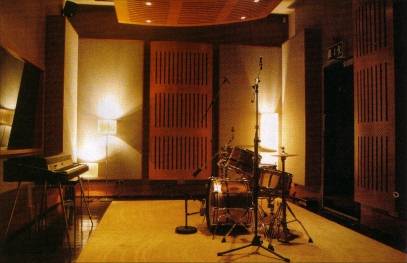 The
beautiful live room, currently home to a Mk I Fender Rhodes Stage Piano
and a Premier drum kit.
The
beautiful live room, currently home to a Mk I Fender Rhodes Stage Piano
and a Premier drum kit.The new studio has a live area with a separate overdub booth, which is big enough to record a chamber ensemble but too small for full orchestral strings. Davidge says he doesn't mind, as he's happy to go to London if that's what a project demands.
"There are some great musicians down here in the South West and, where possible, we do try to keep things local. But for orchestral input you have to go to London, because the musicians there are just incredible," he says.
So if strings will be recorded in London and vocals in the control room, what will the live room be used for?
"Drums," says Davidge. "And guitars — that kind of thing. Although a big live room is what you need for those big drum sounds, we generally prefer drums to be fairly dry, so we can mess around with various effects afterwards. If we'd had a big live room, we'd probably have screened bits off, so we're better off with what we have.
What we wanted to create was a recording space in which to experiment. Personally, I'm not one of those people who likes to say, 'OK, what's the tried and trusted way of recording this Instrument? What's in the manual?' I want to be able to stick microphones everywhere, listen to them and see which ones sound interesting. I want to wheel In odd things like tubing and say 'let's try miking the drum kit through this'. I've actually done that and It was bizarre. It sounded like everything was flanged; an amazing sound.
"At some point, I'm going to have a drum kit In our live room and mike it up all round the building just to see what happens. I'll probably have to do it at night when the road outside is quiet and no one else is around, but I will do it because I want to see how it sounds. It's that potential for experimentation that I've always wanted. We didn't have the space at the old studio and if we went elsewhere, we were up against time constraints and budgets."
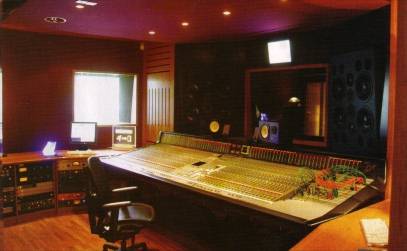
The control room is small (in accordance with Neil Davidge's wishes) but stylish, is centred around the SSL 4000G+ desk, and has a range of monitoring options, from the desktop multimedia speakers and adjacent industry-standard Yamaha NSios on the meterbridge, up to the vast Dynaudio MZ)S mounted in the walls.
Remake, Remodel
The new studio, located on a small industrial estate, took some finding. "We went through various options," says Davidge, "places out in the country, big old barns, that kind of thing, but always within the Bristol area, because this is where we all want to stay. Eventually, after about four years of fruitless searching, we found this place. An industrial estate wasn't exactly what we'd had in mind, but when we saw the space we were being offered, and realised its potential, we decided to go with it."
" Initially, buildings like this were our last choice," admits Del Naja. "But reality crept in, especially as we got towards our lease deadline at our other studio, and we realised that this was going to save us a lot of hassle and planning problems."
The building was already being run as a rehearsal studio and although it was a nightmare of 1970s decoration and in need of a complete overhaul, it did have the bones of a recording area and control room in place. Davidge chose studio-design company Munro Acoustics to handle the refit. "The live room and control room were already in place, so there wasn't too much to change" says Del Naja. "The Munro guys came in and looked at the floor plans, but as the two main rooms were already purpose-built floating rooms, we didn't have to spend any money putting them in. It was simply a case of maximising the audio quality."
The acoustic remodelling was handled by Munro's project managers Phil Pyatt and Andy Lewis. Del Naja: "Munro were given certain criteria regarding the acoustics because we didn't want a live-sounding control room, we wanted it to sound fairly dead." Neil Davidge explains why: "I didn't want the room to sound too live, because I like to record vocals in the control room, so creating a feeling of intimacy was important. I don't like big control rooms anyway; I prefer to have everything within easy reach. The control room was already the right size, so there was no need to change it, although we created a machine room and installed a proper line of sight between the control room and the new live area. We also built a decent reception area, and there are now a couple of programming suites downstairs. We haven't started developing the upstairs yet, but we'll eventually put in a kitchen and lounge so that there's somewhere to relax. It's not uncommon for us to spend 16 hours a day in the studio, so we're very keen to make this a pleasant place to be — and not just for us, but also for the artists we work with."
Gear Heaven
In terms of equipment, the studio features everything that was already in place at Christchurch, plus a number of new additions, including a large console and a 5.1 monitoring system for film soundtrack work, of which more later. The success of Mezzanine and 100th Window/has given Davidge the financial freedom to significantly add to his instrument and equipment list, and he regards it unashamedly as an investment. "The tools of my trade are computers, keyboards, guitars, compressors, and so on, and I've always believed in investing back into my own business. I'm always buying equipment magazines and reading reviews to see what's new on the market."
Digidesign's Pro Tools is still the main recording tool of choice, and since the recording of 100th Window, it has been the main Massive Attack writing medium, too — during that project, they completely abandoned their older hardware samplers and software sequencers, recording everything in Pro Tools as audio.
On the hardware side, recent additions include a Manley EQ, Fairman and Teletronics LA2A compressors, and a Focusrite Liquid Channel. Davidge has also acquired some BLUE and Coles mics, and a couple of guitars. However, the biggest single investment for the new facility was the SSL console, which came from Roundhouse Studios. Del Naja explains: "For the last 10 years, we've been working on an SSL at Olympic, so it's a console we understand and can relate to. Also, we're keen to get [SSL fan] Spike Stent into our studio when the time comes to mix, because he's been a co-collaborator on our albums for a long time. Having a desk he knows and likes will make that much easier."
" It's a G Plus with all the bells, whistles and go-faster stripes," Davidge says. "There's a lot of flexibility with SSL; you can get them to sound really crusty and really warm. Our desk is a good workhorse that does everything we need it to do. We wanted a big console — something that the band could sit in front of, where they could play around with individual faders. Also, we wanted a console that was primarily a recording desk, regardless of whether we're working with Pro Tools or a tape machine. It's not something I will personally drive, as it's Lee's toy [Lee Shepherd, engineer and Davidge's right-hand man]. He's our SSL expert." And not just that, as Del Naja explains. "Lee is a whizz at everything to do with studios and equipment. He's remarkable. He can take the whole studio apart and put it back together again, which is why he's so vital to the success of this place!"
Shepherd also chose the main monitors, Dynaudio M4s. "We were using Genelec 1032As as our main monitors, but they weren't big enough for the new room," Davidge explains. "We checked out various systems and eventually chose the M4s. Main monitors are great for vibe, and there are times when you have to turn them up loud, but mostly I prefer to listen to them quietly. Playing them at full volume allows you to judge interaction and hear resonant frequencies, but there's no need to make your ears bleed. You can sense power from a track by the interaction of the sonics; you don't need volume. If you can't judge properly at low volumes, you're doing something wrong."
For nearfield work, Davidge has his Genelecs and a pair of ubiquitous Yamaha NS1 Os. He also likes playing with cheap and cheerful computer speakers so that he can tell how the track might sound when his audience plays it at home. "When you're in the studio it's very difficult to judge what your track will sound like on any old system. Our approach is to stem the mix down into eight tracks of stereo, then put that through cheap computer speakers and listen to what's happening. Is the snare drum in front of the vocal? Is the guitar solo drowning everything out? You get a feel for the overall perspective, which is important when you're mixing, because if you record a great vocal and then mix it down by as little as half a decibel too much, you can end up clouding the song. Half a decibel may not sound much, but it's enough to make all the difference to the intelligibility. Keeping a sense of perspective like this is especially important when you've been working on a track for a long time, and have got to the stage where you know every single note, every single sound, every single bit of crackle and buzz. At that point, trying to put yourself into the headspace of the person who is listening for the first time is very, very difficult."
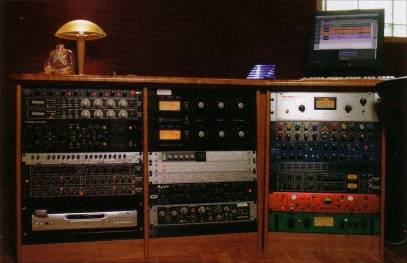 As you would expect, the studio contains some of the finest
processors in the world, including an SPL Transient Designer, two Empirical
Labs Distressors, an
Audio & Design Fy6oXRS compressor/limiter/expander, a Focusrite Platinum
Compounder, a Drawmer LX20 dual expander/compressor and two DS201 dual gates,
Fairman and Smart Research C2 compressors, a Mutronics Mutator filter bank, an
Electrix Filter Factory, a Teletronix LA2A compressor, a Massenburg Model 8000
EQ, a Tubetech LCA2B compressor, a Drawmer 1960 valve compressor/preamp, a Focusrite
Red 7 mic preamp/dynamics processor, and a joemeek stereo compressor.
As you would expect, the studio contains some of the finest
processors in the world, including an SPL Transient Designer, two Empirical
Labs Distressors, an
Audio & Design Fy6oXRS compressor/limiter/expander, a Focusrite Platinum
Compounder, a Drawmer LX20 dual expander/compressor and two DS201 dual gates,
Fairman and Smart Research C2 compressors, a Mutronics Mutator filter bank, an
Electrix Filter Factory, a Teletronix LA2A compressor, a Massenburg Model 8000
EQ, a Tubetech LCA2B compressor, a Drawmer 1960 valve compressor/preamp, a Focusrite
Red 7 mic preamp/dynamics processor, and a joemeek stereo compressor.
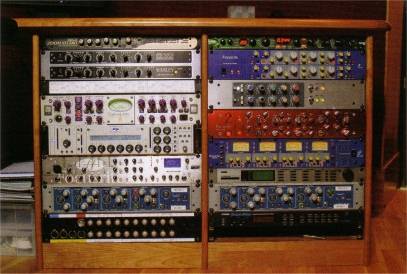 There's
a more curious mix of budget and high-end in this rack, including Manley,
Neve, Avalon and Focusrite EQs and voice channels (including the
new Liquid Channel and Voicemaster Pro), and Zoom Studio effects, two Electrix
MOFXs, a Line 6 Echoplex, and an old Alesis Quadraverb!
There's
a more curious mix of budget and high-end in this rack, including Manley,
Neve, Avalon and Focusrite EQs and voice channels (including the
new Liquid Channel and Voicemaster Pro), and Zoom Studio effects, two Electrix
MOFXs, a Line 6 Echoplex, and an old Alesis Quadraverb!
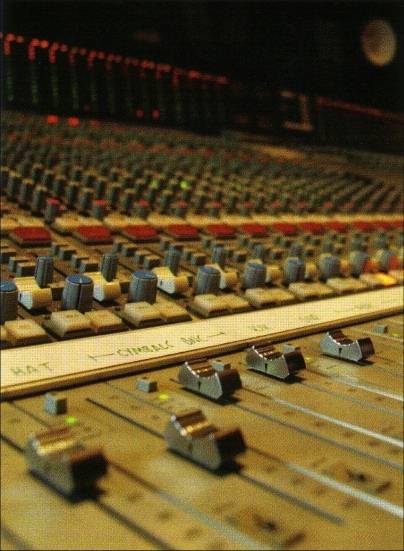
Cutting Remarks
Whether he's working
on a film score or an album track, Del Naja believes the most important part
of the creative process Is editing.
"That Is what defines everything. You can have loads of great ideas and
be sketching different sounds in the studio, but unless you put them into
order and context, your work won't have any meaning for anyone else. Editing
is creative
in its own way, because It's where you choose what
people will hear.
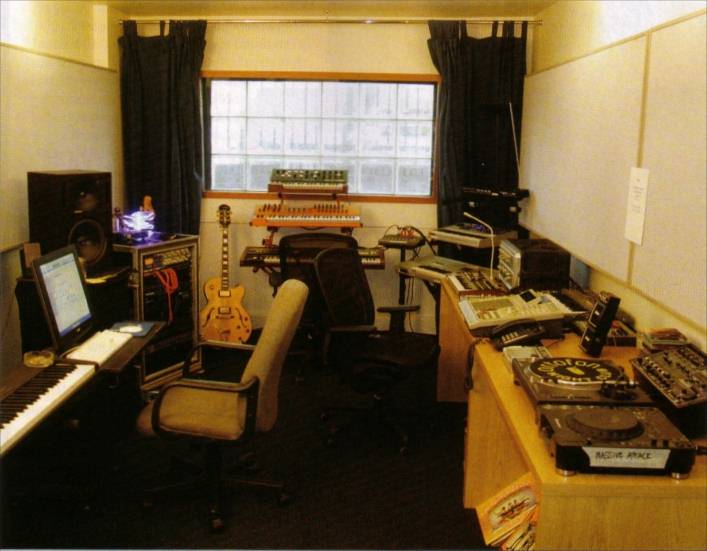 One
of the programming suites at the new facility is itself a dream project
studio, with a treasure trove of fantastic kit. The keyboards at the far
end are a Moog Prodigy, a Waldorf Microwave XT, and a Roland )uno 60, while
off to the right there's a Noiderland Stereo Theremin, an Access Virus
Indigo 2, and a Korg Triton. There are more rackmount synths and sound
sources next to the guitars on the left, including an Oberheim Matrix woo,
Novation Drumstation, Roland MKS/o and JVloSo, with a Focusrite ISA430
channel strip. The worksurface on the right seems more dedicated to rhythm
creation, with a Korg Microkorg synth, Electrix Filter Factory and MOFX
processors, an Akai MPC3000 sampling workstation and a Roland SHwi monosynth,
a Korg Electribe RX rhythm box and two Kaoss Pad controllers (an original
and a Mkll model). Finally, there's a Technics vinyl deck, a Pioneer CD
turntable, and a Numark D) mixer. A selection of vinyl can just be seen
under the table, with the Residents and the Beatles to the fore! Just out
of shot by the master keyboard and Pro Tools rig on the left of the room
is a large screen for use in Davidge
and
Del Naja's music-for-picture work.
One
of the programming suites at the new facility is itself a dream project
studio, with a treasure trove of fantastic kit. The keyboards at the far
end are a Moog Prodigy, a Waldorf Microwave XT, and a Roland )uno 60, while
off to the right there's a Noiderland Stereo Theremin, an Access Virus
Indigo 2, and a Korg Triton. There are more rackmount synths and sound
sources next to the guitars on the left, including an Oberheim Matrix woo,
Novation Drumstation, Roland MKS/o and JVloSo, with a Focusrite ISA430
channel strip. The worksurface on the right seems more dedicated to rhythm
creation, with a Korg Microkorg synth, Electrix Filter Factory and MOFX
processors, an Akai MPC3000 sampling workstation and a Roland SHwi monosynth,
a Korg Electribe RX rhythm box and two Kaoss Pad controllers (an original
and a Mkll model). Finally, there's a Technics vinyl deck, a Pioneer CD
turntable, and a Numark D) mixer. A selection of vinyl can just be seen
under the table, with the Residents and the Beatles to the fore! Just out
of shot by the master keyboard and Pro Tools rig on the left of the room
is a large screen for use in Davidge
and
Del Naja's music-for-picture work.
From Sound To Pictures
The writing and production
collaboration between Neil Davidge and Robert Del Naja is now well established,
having spawned two albums and, most recently, a host of film music including
the soundtrack for Luc Besson's movie Unleashed. Given that both Davidge
and Del Naja come from art backgrounds (Davidge was once a graphic designer
and
Del Naja is both an artist and a musician), it's no surprise that the pair
have embraced
film music to such a large extent. " From the start, our music has been
used in film, and we've been part of the film process through our videos," says
Del Naja. "It was inevitable
that we would get involved with film scores. As a lyricist, you absorb ideas
from TV and film — you can't
help it. With film scores, it's more a case of noticing how an atmosphere
works in a film, and how the music fits in. This
is something we always
wanted to do."
"It has always interested us, because we do have a very visual approach
to music," agrees Davidge. "Although
the Unleashed soundtrack is the most intensive project we've done so far,
we didn't come at that from a standing start, as
we'd already completed tracks for a Robert
De Niro film and written music for the Day Of
The Jackal remake."
Davidge
adds that writing for the big screen is more than just creatively satisfying —
it's also the perfect complement to album recording, which he admits can be
quite stressful at times. "The problem
with making albums is that there's huge pressure on you to keep re-inventing
yourself, and that's really, really hard.
Also, it's not uncommon for us to take a year
or more to make an album, which is a long time
when compared to most other bands, and you do
get into a weird place mentally when you're involved
with an album project that's been going
on for so long. So we're always trying to
find ways to break out of that, and film
work is a great way to do it. You're working
on someone else's, project and vision, which is
incredibly liberating. Who, for instance, would
think of Massive Attack doing a ballad? You just wouldn't
expect that on one of our albums,
but with film, we have that flexibility."
Del
Naja echoes this, and adds that writing for film is a very different process,
because it is linked to a visual,
which gives you a guide as to what works
and what doesn't. "You
know how far you can take the music, and what's absolutely wrong and incongruous.
This isn't the case with album tracks,
because there the process involves instruments,
lyrics and an inevitable amount
ofrandomness, so you're not sure for a long time
if you're achieving what you set out to achieve.
And often a track will move in
a totally different direction, because you have
no parameters set in advance. Sometimes
you get a perfect moment when you have a
simple song, a simple idea, and it's beautiful;
you know you hardly have to touch it. But more
often, there's a lot of messing around
and experimenting before you get
to where you
want to be. With film, you are also
part of someone else's project — you're
not in control of it, and that's quite nice, in a way. You don't lose sleep
over it, because you're not so emotionally
attached, and so you try things you wouldn't normally
do."
The Unleashed
soundtrack album, which was released by Virgin at the end of last year under
the title Danny
The Dog (after the name of the film's main
character) features 21 Massive Attack
tracks from a total of more than 50 that were created
for the movie. Davidge says: "We were
given a finished cut of the film and were told to do what we wanted. The result
is
wall-to-wall music—about
90 minutes of it — which
we did in just over three months. Most of it was written from scratch. And
we were doing that while trying to build a studio
and write new material for our next album, so you
can imagine the kind of hours we were putting
in!" As
the new studio wasn't ready at this point, the bulk of the soundtrack was
recorded at Christchurch using the band's own
Pro Tools setup. Strings were recorded
at Angel in London and the whole lot was eventually
delivered to director Louis Leterrier for
inspection.
"Louis was great — a joy to work with," Davidge says. "He
would explain the scenes and give us some idea of what he wanted, but he
was very respectful of what we'd done in the past and gave
us creative freedom. We both sat in our room
playing piano, looking up beats and coming up with
some bizarre effects that we collected
together as a lot of rough sketches. We gave
them to Louis who took them away to see
what fitted. He cut some of the music to
a few scenes to show how he thought certain tracks
might work. It was a great way of working,
because we'd seen the film and had an
overview of what it was all about without getting
too specific in the
studio. It was more a case of what each scene made us feel, musically."Leterrier
made it clear that the music was to be the film's focal point. He wanted it mixed
at high
volume levels and, crucially, he didn't want the volume turned down for the
dialogue. This
meant careful attention to the arrangement. If
something in the frequency range clashed with the dialogue,
then Davidge and Del Naja had
to change it. "It
was incredibly difficult and challenging, but I think we achieved what he wanted," Davidge
comments.
A 5.1 mix
was created at Luc Besson's film studios in Normandy with the help of sound
designer Vincent
Tulli. " Louis
wanted the surround effect to be quite extreme, not just a bit of reverb panning
around at the back," says
Davidge. "He wanted the sound everywhere,
so that the whole thing became an experience. This meant that we went to
town with 5.1, which was fun for
us because it was the first time we'd
really played with it. We had Vincent
in the studio with us and his experience
was invaluable. Lee would
mix the track and get it to a certain stage, then
Vincent would come in and
start panning sounds around to see what
worked. Most of this was done using
the automation within Pro Tools and involved
quick movements that were quite
frenetic. Very few people have used
5.1 in such an extreme way on a film.
There were one or twooccasions when
Vincent went too far and it started
to sound annoying, but overall we
loved the effect, and we learned
a lot from the experience."
Unleashed
was followed by another film project — a British film called Bullet Boy.
This helped consolidate Davidge and Del Naja's 5.1 expertise, and they now
feel very
confident with the format. "The
best approach is to mix the music in quad, which is very easy to do from stems," explains
Davidge. "You
can also derive a sub channel from this, and leave the centre channel free
for dialogue. It's onlywhen you
have music and no dialogue that you need to use the centre
channel, usually for a lead instrument or a
specific sound effect. Once we've put down
our stems and worked out our 5.1, we hire
out a small Pro Tools rig to the film company
for the final mix. If they want to
push the 5.1, they can, but if they want to
tone it down, they also have that option. We
give them all the stems, so if there's a single
instrument getting in the way, they can
change it — it
gives them a lot more control. We don't shirk our responsibilities for
getting it right, but we do leave enough room
for the client to make the adjustments that suit them."
What Next For Massive Attack?
Since opening the new studio at the beginning of this year, Davidge and Del
Naja have been focusing on film scores, having formalised their working relationship
by setting up a music production
company, 100 Suns. And a new Massive Attack
album is in the works, currently planned
for release in 2006. Del Naja has already
recorded a few rough tracks, and they
also have material from Grant Marshall, who took
time out from Massive Attack while the
band recorded 100th Window to fulfil personal
commitments. He's back now and fully involved,
which they're all delighted about.
Davidge
says: "We have a lot of sketches — about
40 so far, some of which were archived from previous projects but are worth
re-working. There's always cross-fertilisation going on and we do tend
to file things. We may be working on a remix for someone
when we come across a sound
that's so great we'll put it aside and keep it
for the next album. Also, while we've
been working on film material, we've
come up with ideas that are better as album tracks.
Lee is our archivist and keeps everything,
because we have great memories for those
gems we didn't find a home for at the time.
It might just be a sound or a rhythm pattern,
but we'll remember it, and then get Lee to
find it. He has a hell of a job, especially
when we haven't given it a name!"
Inevitably,
the construction of the studio and the 100 Suns film work has slowed progress
on the new album. "This
year has been about making progress with 100 Suns and establishing ourselves
with the film industry," says Del Naja. "We've
had to build trust with these people, because if they are going to commit to
us, they need to know we won't let them — or
their deadlines — down." However, the
film work has also influenced the new album in positive ways, inspiring a couple
of potential tracks, as Davidge has already mentioned, and
giving the creative process a different
emphasis. "In
the past, we've written instrumental parts first and fitted songs around them," says
Davidge, "but this time, we're using the film-score approach, putting
down quick sketches so that we get basic chord structures going — melodies,
riffs and so on — to give us
an idea of how the backing track might sound. In theory, this should make the
process a lot quicker, and enable us to keep
everything feeling fresh. It might also
stop us becoming so bored with a track that we
end up changing it at the mix!"
Previous Massive Attack albums have seen vocal collaborations with carefully
chosen guests such as Tracey Thorn, Tricky, Liz Frasier and Sinead O'Connor.
So who's on the new album?
"We have several possibilities, but I can't say who yet; negotiations
are still at a delicate stage," says
Davidge. " We've sent out rough sketches and hopefully, over the next
month or so, we'll sit down with a few people and see what happens. They may
be surprising from
the point of view of not being
particularly well known. These days, we
can go for what interests us' rather
than what has commercial appeal.
The band has worked with some great
singers in the past, and it's been a highlight
of my career to do that, but
with established singers, the pressure on us is
to find something new within them, and that
can be a distraction from just trying to get something
good. So some people we use may not be well
known for that reason."
As
our interview draws to a close, Del Naja explains that the 100 Suns film work
has positively
influenced Massive Attack's working methods
in this area,
too, providing another potential avenue
for collaboration with vocalists. "100 Suns gives
us the freedom to try different people for different reasons. One of the films
we hope to be doing in the New Year
has an emphasis on soul music, so we're collaborating
with people like Bobbie Womack and Terry
Callier. It would be great to use
Terry on the album as well as the film score.
That's an opportunity that's come about
as a result of 100 Suns and the film projects — without
that, it might not have happened."
Sue Sillitoe




